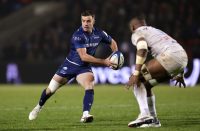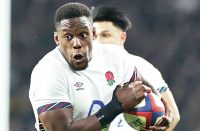 What has happened to the once proud record of English clubs in Europe? When Saracens slipped out of the Heineken Cup a fortnight ago after a surprisingly lacklustre semi-final defeat by Toulon at Twickenham, it meant that no Premiership side would be competing in Saturday’s final in Dublin. It also ensured that for six years there has been no English winner.
What has happened to the once proud record of English clubs in Europe? When Saracens slipped out of the Heineken Cup a fortnight ago after a surprisingly lacklustre semi-final defeat by Toulon at Twickenham, it meant that no Premiership side would be competing in Saturday’s final in Dublin. It also ensured that for six years there has been no English winner.
It is a worrying trend considering that three Premiership clubs – Harlequins, Leicester and Saracens – made it through to the quarter-finals. However, what is of greater concern is that none of them had squads with the star quality or depth of French Top 14 rivals like the two finalists, Clermont Auvergne and Toulon.
Underpinning the failure of any English club to win the Heineken Cup since Wasps in 2007, are the funding and PRO12 automatic qualification issues that has led PRL, the Premiership’s administrative body, into conflict with ERC, the tournament organisers. PRL have already given notice that their clubs will withdraw after next season’s tournament.
However, there are funding issues closer to home which are not helping the English cause. The first is the £4.5m salary cap.
PRL have been slow to recognise that English clubs good enough to compete at Europe’s top table are having their purchasing power and ability to compete restricted unfairly by their own policies.
The most significant self-inflicted shortfall they suffer is because of PRL’s insistence that Elite Player Squad (EPS) payments to clubs in compensation for their England players being on international duty are included in the salary cap.
At almost £190,000 per international player per season it is a significant penalty, especially for leading clubs like Leicester, Harlequins, Saracens and Northampton, who provide significant numbers to England and Saxons squads.
 It means also that clubs good enough to produce international players are paying an unacceptable price for doing so. Not only do they lose their best players, they are unable to use the compensation to buy talented replacements.
It means also that clubs good enough to produce international players are paying an unacceptable price for doing so. Not only do they lose their best players, they are unable to use the compensation to buy talented replacements.
Leicester, for example, have six players in the current England squad. If, for arguments sake, they all stayed in the squad for a season it would amount to EPS compensation of £1.14m.
If Leicester were able to add that money to their salary cap, raising it to £5.64m, it would enable them to buy marquee players, such as Toulon’s Jonny Wilkinson, Matt Giteau or Bakkies Botha, and perhaps become European champions again for the first time since 2002.
I have argued that success in pro rugby is dictated more by culture, such as good selection and player development, than it is by purchasing power. I still broadly subscribe to that view, however the evidence is overwhelming that a sprinkling of world-class talent in a squad can be the difference between winning Heineken Cups or being perpetual bridesmaids.
Take the supercharged contribution that Wallaby back rower Rocky Elsom made to the first of Leinster’s three Heineken Cup titles in 2009. Other Leinster examples are the counter-attacking of Isa Nacewa who helped to inspire their epic comeback in the 2011 final against Northampton, while Brad Thorn, the veteran All Black lock, made a significant contribution to them retaining the title last season.
The PRL policy of equalising payments to their clubs, thereby giving the ambitious the same rewards as the average, is also evident in the way that they handle the RFU’s English Qualified Player (EQP) incentives to develop English talent.
Although the RFU pay each club about £90,000 if they reach the minimum EQP target of an average of 16 English players in their match day 23 over the season, those who field more do not get further financial benefit.
This is because PRL operate an equalisation scheme, reducing the central funding (from broadcasting and sponsorship) to clubs whose EQP payments from the RFU are higher than the norm.
These financial penalties levied by PRL on the clubs who are England’s standard-bearers in Europe appear to be a recipe for mediocrity. Six years and waiting.






















